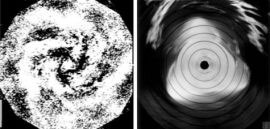| Posted: January 8, 2009 |
Montreal researcher physically validates Nobel Prize winner J.J. Thomson's 125-year-old theory on the stability of vortex rings |
|
(Nanowerk News) Research into the stability of vortex rings by Concordia professor George Vatistas has been chosen as one of the top ten discoveries of 2008 by the magazine Québec Sciences. Each year the popular science magazine dedicates its February edition to highlighting what it considers to be the ten best research discoveries of the year. This list is determined by a jury made up of researchers and science journalists.
|
|
Even though Vatistas is a professor of mechanical engineering, his discovery is based in physics. Vatistas is the first person to physically validate Nobel Prize winner J.J. Thomson's 125-year-old theory on the stability of vortex rings. Researchers had always believed the theory was mathematically sound, but nobody had been able to physically prove it until now.
|
 |
| Computer enhanced NGC 598 galaxy image (Elmegreen et al 1992 “Optical Tracers of Spiral Wave Resonances in Galaxies, II. Hidden Three-Arm Spirals in a Sample of 18 Galaxies”. The Astronomical Journal Supplementary Series, 79:37-48, March 1992).
|
|
"The work done by Dr. Vatistas and his team is another example of the extraordinary research being done at Concordia," said Judith Woodsworth, Concordia President and Vice-Chancellor. "This discovery is a significant step forward for science and knowledge. The entire Concordia community is extremely proud of this recognition."
|
|
It was almost 20 years ago that Vatistas encountered the phenomenon for the very first time while researching another subject. In 1989, he was exploring the properties of water vortices by spinning up liquid in tall slender cylinders. Instead of the relatively smooth-sided funnel he was expecting, large waves undulated up the length of his whirlpool, obstructing the view of the central core he wanted to study.
|
|
This physical validation allows scientists to take physics into directions they were unable to before, from the physics of the very small (quantum) to the physics of enormously large (galaxies). This theory is used in the study of anything in the universe that rotates, from water to stars to electrons to acoustics in sound waves. The real-world applications are limitless and can be applied towards areas like the forecasting of tornado development before it appears on radars to the design of airplane wings. In other contexts companies will be able to build more efficient and quieter components in machinery such as turbines.
|
|
This groundbreaking research was featured in Physical Review Letters ("Experimental Confirmation of Kelvin’s Equilibria"). For more information contact Dr. George Vatistas at [email protected] or 514.848.2424 ext. 3158.
|

